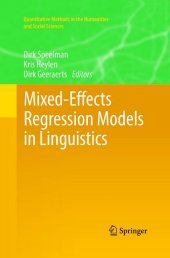 Neuerscheinungen 2019Stand: 2020-02-01 |
Schnellsuche
ISBN/Stichwort/Autor
|
Herderstraße 10
10625 Berlin
Tel.: 030 315 714 16
Fax 030 315 714 14
info@buchspektrum.de |

Dirk Geeraerts, Kris Heylen, Dirk Speelman
(Beteiligte)
Mixed-Effects Regression Models in Linguistics
Herausgegeben von Speelman, Dirk; Heylen, Kris; Geeraerts, Dirk
Softcover reprint of the original 1st ed. 2018. 2019. vii, 146 S. 17 SW-Abb., 18 Farbabb., 20 Farbtabel
Verlag/Jahr: SPRINGER, BERLIN; SPRINGER INTERNATIONAL PUBLISHING 2019
ISBN: 3-319-88850-1 (3319888501)
Neue ISBN: 978-3-319-88850-7 (9783319888507)
Preis und Lieferzeit: Bitte klicken
When data consist of grouped observations or clusters, and there is a risk that measurements within the same group are not independent, group-specific random effects can be added to a regression model in order to account for such within-group associations. Regression models that contain such group-specific random effects are called mixed-effects regression models, or simply mixed models. Mixed models are a versatile tool that can handle both balanced and unbalanced datasets and that can also be applied when several layers of grouping are present in the data; these layers can either be nested or crossed.
In linguistics, as in many other fields, the use of mixed models has gained ground rapidly over the last decade. This methodological evolution enables us to build more sophisticated and arguably more realistic models, but, due to its technical complexity, also introduces new challenges. This volume brings together a number of promising new evolutions in the use of mixed models in linguistics, but also addresses a number of common complications, misunderstandings, and pitfalls. Topics that are covered include the use of huge datasets, dealing with non-linear relations, issues of cross-validation, and issues of model selection and complex random structures. The volume features examples from various subfields in linguistics. The book also provides R code for a wide range of analyses.
Chapter 1. Introduction.- Chapter 2. Mixed Models with Emphasis on Large Data Sets.- Chapter 3. The L2 Impact on Learning L3 Dutch: The L2 Distance Effect Job.- Chapter 4. Autocorrelated Errors in Experimental Data in the Language Sciences: Some Solutions Oered by Generalized Additive Mixed Models.- Chapter 5. Border Effects Among Catalan Dialects.- Chapter 6. Evaluating Logistic Mixed-Effects Models of Corpus-Linguistic Data in Light of Lexical Diffusion.- Chapter 7. (Non)metonymic Expressions for Government in Chinese: A Mixed-Effects Logistic Regression Analysis.
"I assume that the intended primary audience for this book is those scientists working linguistic domain. I would safely conclude that that book is also useful for those who are interested in, collecting, and analyzing such data in other fields of applications." (S. Ejaz Ahmed, Technometrics, Vol. 60 (3), 2018)


